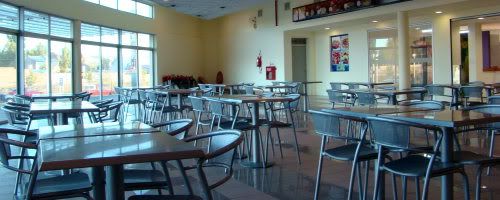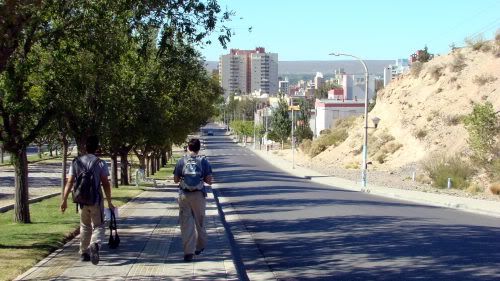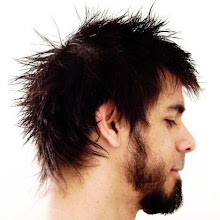Although in my last post I said "this was our last day in Malargüe", I should've said "our last whole day". We had to go from there to Neuquén, but what should be the most direct path was unavailable — National Route 40, which goes south across the desert, has been in the same sorry state since ever, and you can't use unless you have a special vehicle. So instead of going straight south into Neuquén Province and reach Chos Malal, you have to go north-northeast to San Rafael, and then east and back south along the border of Río Negro, get to Cipolletti, cross the river and then you're in Neuquén City. That's an almost semi-circular route that takes about eight hours for a trip that should take at most five.
So, in order to avoid paying for an extra night and/or arriving at ridiculous times, we stayed in Malargüe half of the next day, then took the 3-hour bus ride to San Rafael, rested a bit there (outside that creepy bus station!), had dinner, and then at about 11 PM boarded the bus to Neuquén. The trip was unenventful. I slept through the night, and woke up at dawn as we arrived in Cinco Saltos, less than an hour before our destination.
Neuquén's bus terminal station is almost brand-new, and it looks more like an airport, with lettered embark gates and all. Everything seems to be neatly organized, if only a little sterile.

Neuquén itself seems to be a fairly modern city. The downtown area (where I stayed at all times) is within the limits marked by National Route 22 and the river. There are a couple of wide avenues and a lot of trees lining the streets, but no large parks (that I know of). Constant irrigation of grass in public spaces through sprinklers is conspicuous; this is still, after all, semi-arid Patagonia, and only the fact that it's at the junction of two large rivers spares it from being a bone-dry plain.
Visitors looking for historical buildings and sites will also be rather disappointed; even to the untrained eye Neuquén shows a complete lack of old architectural styles. The city looks neat, like its bus station, and much unlike Rosario or Buenos Aires with their layers and layers of new and old dirt and cracks, with their half-visible cycles of destruction and reconstruction.

Neuquén was a small frontier town when the big cities of central Argentina were already metropolises. It was at the border of civilization, the equivalent of the American Far West, at the beginning of the 20th century, a couple of decades after the "Conquest of the Desert" (i.e. the government-sponsored genocide of the Patagonian natives and the subsequent occupation of their lands, in several waves), and continued to be a small city until oil was discovered in the area in the 1960s.
Well, we found our little hotel quite easily and checked in. It wasn't a pleasant experience. The owner of the hotel was a Polish immigrant who must have seen World War I with her own eyes, a bit hard of hearing to say the least, extremely methodical, rather reserved, and mindful of waste to the point of pasting newspaper articles and warning signs about water and energy conservation. She charged quite a lot for a rather basic service, though in her defence I must say all of Neuquén City is terribly expensive. No kitchen, no space for laundry, no breakfast, and no showers unless you paid an extra fee, and this was more expensive than the (infinitely better) hostel I found in San Martín de los Andes.
Neuquén City seems not to have understood its own touristic potential for budget travelers looking for a conveniently urban base for exploration. If it weren't for the outrageous prices, I would've stayed 4 or 5 days, and explored the whole Alto Valle area of Río Negro and the interior of Neuquén (such as the oil towns of Plaza Huincul/Cutral-Có and Zapala). As it was, we decided to cut it to only 2 nights.
On the first day we decided to do some reconnaisance. We walked around town, I took pictures, we got some information from the tourism office, and we came to the conclusion that trying to move around without a car and without paying ridiculous sums of money to an agency was pointless. This was just not a touristic part of the province, period.
So in the afternoon we followed the tourism office's advice and visited the beach. Neuquén has three public beach resorts, all easily accessible on foot, about 2 km from Route 22. We chose one and settled on the sand. The day was rather hot, so we bathed in the river, and then came back to dry in the sun. By pure luck we caught a kayak regatta in progress (nice colourful pictures for moi).
By this time, incidentally, we'd gotten accustomed to using sunblock all the time we were outdoors. I'd taken the precaution of getting some protective tan before leaving Rosario, but still the Patagonian sun was terrible, and soon we were all quite red, sunblock notwithstanding. I'm naturally dark, so I didn't get burned, but I came back almost chocolate-brown and peeling in a couple of spots.














No comments:
Post a Comment
Note: Only a member of this blog may post a comment.